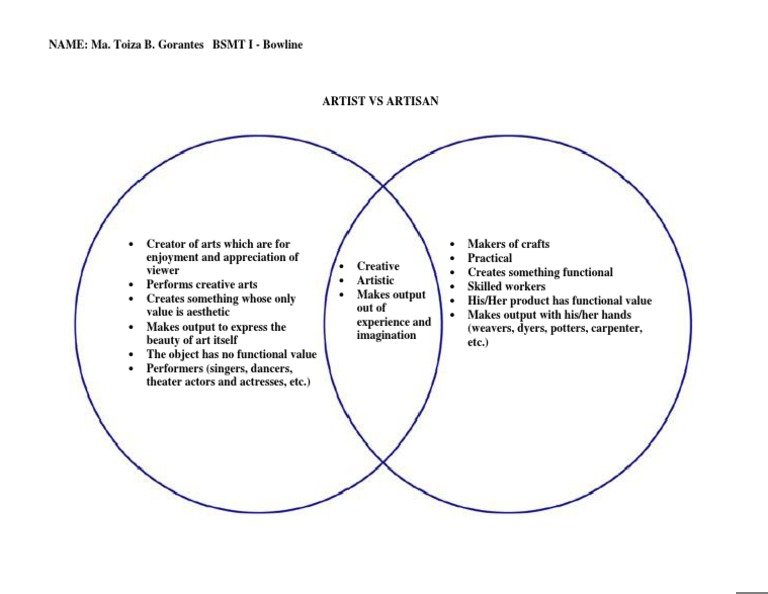An artist and an artisan may both create, but their paths diverge in intent and execution. The difference between artist and artisan lies in the approaches they take to their craft. Artists often express emotions, ideas, or social commentary through their work, embracing creativity without constraints.
On the other hand, artisans focus on skill and technique, producing functional or decorative items with precision and craftsmanship. Each plays a vital role in the world of creation, shaped by their unique motivations and methods. Understanding this distinction enriches our appreciation of both.
Understanding the Difference Between Artist and Artisan
When we think about creativity and craftsmanship, two terms often come up: “artist” and “artisan.” These words may seem interchangeable at first glance, but they represent distinct concepts that have specific meanings in the world of creativity. This article will explore the differences between an artist and an artisan, diving deep into their unique characteristics, processes, and contributions to culture and society.
Defining the Terms
Before we delve into the differences, let’s clarify what we mean by “artist” and “artisan.”
What is an Artist?
An artist is often seen as someone who creates work primarily for self-expression, exploration, and emotional impact. Here are some key points about artists:
- Artists use various mediums such as paint, clay, digital tools, and more.
- Their work often conveys feelings, concepts, or abstract ideas.
- Examples include painters, sculptors, musicians, writers, and dancers.
- Art is typically subjective and open to interpretation by the audience.
What is an Artisan?
An artisan focuses on the craftsmanship of creating functional items, often combining skill with traditional techniques. Here are several points to characterize artisans:
- Artisans create handmade goods, often focusing on functionality and aesthetics.
- They may work with materials like wood, metal, glass, and textiles.
- Examples include potters, blacksmiths, weavers, and woodworkers.
- Their work is usually tied to cultural or historical significance.
Examining the Core Differences
Now that we have a foundation, let’s explore the core differences between artists and artisans. These differences can be examined through various lenses, including purpose, process, skill level, and audience interaction.
Purpose and Intention
The intention behind the creation often sets artists and artisans apart:
- Artists aim to express ideas, emotions, or narratives. They often prioritize personal vision and exploration over practicality. For example, a painter may create a piece to convey a message about society.
- Artisans focus on producing functional items that serve a purpose while also being aesthetically pleasing. For instance, a potter creates dishes that can be used in everyday life.
Process and Technique
The methods of creation also differ between the two:
- Artists may use experimental techniques, often pushing boundaries of traditional art forms. They are free to explore various styles and mediums without restriction.
- Artisans typically rely on learned techniques passed down through generations. Their work often involves a high level of skill and craftsmanship, with a focus on precision and quality.
Skill and Training
The journey of becoming an artist or artisan can vary considerably:
- Artists may or may not undergo formal training. Many artists develop their skills through personal exploration and experimentation rather than through structured education.
- Artisans often engage in apprenticeships or formal training in their craft. They hone their skills and techniques over years to achieve mastery.
Audience Interaction
The relationship between the creator and their audience also varies:
- Artists often seek emotional reactions from their audience. Their work may evoke feelings, provoke thought, or challenge societal norms.
- Artisans connect with their audience through functionality. While their creations may also be beautiful, the primary focus is on the utility and craftsmanship of the item.
Exploring Examples
To better understand these differences, let’s look at some specific examples that illustrate the distinction between artists and artisans.
Example of an Artist
Consider a contemporary painter like Banksy. His work often carries strong political messages and social commentary. He paints murals that stir emotions, provoke thoughts, and encourage dialogue among viewers. The intent behind his work is to communicate and challenge societal beliefs rather than to create a functional object.
Example of an Artisan
On the other hand, think of a skilled furniture maker who creates handcrafted tables and chairs. This artisan uses techniques that have been refined over time to produce beautiful, functional pieces. Their goal is to create something useful that also has an aesthetic appeal, ensuring customers appreciate both form and function.
The Overlap: When the Lines Blur
While it’s essential to recognize the differences, it’s equally important to understand that there can be overlap between an artist and an artisan.
Artisan as an Artist
Many artisans infuse artistic expression into their work. For example, a glassblower not only creates beautiful glass objects but often adds personal touches that reflect their artistic vision.
Artist as an Artisan
Conversely, some artists might create functional works. An example is a sculptor who makes intricate vases or bowls that can serve as decorative objects. These pieces maintain artistic flair while also being usable items.
Cultural Significance
Both artists and artisans play crucial roles in cultural identity and heritage. Their contributions help preserve traditions and promote innovation in various forms. Let’s examine this further.
The Role of Artists in Culture
Artists often challenge the status quo and inspire movements. They can shine a light on social issues, making people aware of important topics. Here are some ways artists contribute:
- They document history through their works.
- They create dialogues around contemporary issues.
- They inspire new ideas in various fields, including fashion, literature, and music.
The Role of Artisans in Culture
Artisans help preserve traditional crafts and techniques that have been handed down through generations. Their work often reflects cultural identity, community values, and historical significance. Here’s how artisans contribute:
- They keep cultural traditions alive through crafting methods.
- They provide a sense of identity and heritage to communities.
- They contribute to local economies through handmade goods.
In summary, while both artists and artisans play valuable roles in society, their purposes, processes, and interactions with their audiences differ significantly. Artists often prioritize expression, emotional depth, and personal narratives, while artisans focus on craftsmanship, functionality, and traditional techniques. However, the lines can blur, and their contributions to culture and heritage are both significant. By understanding these differences, we can better appreciate the unique value each brings to the world of creativity and craftsmanship.
Art Appreciation: Artist and Artisan
Frequently Asked Questions
How do the purposes of artists and artisans differ?
Artists primarily aim to express personal feelings, ideas, and concepts through their work. Their goal often revolves around exploring themes, evoking emotions, and pushing boundaries within the art world. In contrast, artisans focus mainly on creating functional items or objects that demonstrate craftsmanship and skill. Their work usually serves a practical purpose, such as furniture, pottery, or textiles, while also showcasing their technical abilities.
What types of skills do artists and artisans typically possess?
Artists usually cultivate skills related to creativity, innovation, and abstraction. They often work with various mediums, such as painting, sculpture, or digital art, and rely on their imaginative capabilities to produce unique works. Artisans, on the other hand, develop technical skills specific to their craft. They refine their abilities in areas like woodworking, metalworking, or ceramics, focusing on precision and attention to detail to create high-quality products.
How does the creative process differ for artists and artisans?
Artists often engage in a process driven by inspiration, experimentation, and self-expression. They may explore different concepts without restrictions, letting their ideas evolve organically. Conversely, artisans follow a more structured approach, adhering to traditional techniques and methods. Their creative process emphasizes mastering skills and producing items that meet specific standards of quality and functionality.
Can an individual be both an artist and an artisan?
Yes, an individual can embody characteristics of both an artist and an artisan. Many people blend creativity with craftsmanship, producing unique pieces that serve both aesthetic and functional purposes. For instance, a potter might create artistic pottery that is also functional, combining artistic expression with skilled craftsmanship.
How does the cultural perception of artists and artisans differ?
Culturally, society often elevates artists to a status associated with high expression and intellectual contribution, viewing their work as a significant part of cultural dialogue. In contrast, artisans may receive recognition for their craftsmanship and practical skills, but they might not always enjoy the same level of prestige. This perception varies across cultures and can evolve over time, as appreciation for different forms of creativity continues to grow.
Final Thoughts
The difference between artist and artisan lies in their approach and intent. Artists often emphasize personal expression and creativity, exploring emotions and concepts through their work.
In contrast, artisans focus on craftsmanship and technique, creating functional or decorative items with skill and precision.
While both roles involve creativity, artists prioritize originality, while artisans value tradition and skill in their craft. Understanding this difference enriches our appreciation for both forms of creativity and the unique contributions each makes to culture and society.
















